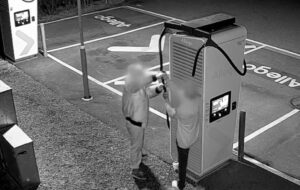As more and more people purchase electric vehicles (EVs) there is a growing number of concerns about what happens if these vehicles set on fire. Air Quality News reporter Pippa Neill has set out to debunk the myths and understand the true risks of electric vehicle fires.
The electric vehicle market has seen exponential growth in the past decade.
Almost 100,000 new EVs are expected to be registered in the UK this year alone, and in April 2020, EV sales surpassed petrol and diesel vehicles for the first time ever.
Despite the undoubtable benefits of electrifying our transport fleet – from reduced air pollution to enabling us to achieve the essential net-zero targets – among the EV community there is a growing sense of concern about the dangers and apparent spontaneity of EV fires.
Causes of an EV fire
Electric vehicles are powered by a rechargeable lithium-ion battery. The first lithium-ion battery was invented in the 1990s and it was used to power a car in the early 2000s.
In comparison, petrol and diesel vehicles have been around for well over 100 years, so comparatively we are yet to obtain the same data and understanding when it comes to product safety.
Fundamentally, electric vehicles are extremely safe, but the main danger occurs when the lithium-ion battery is damaged, which might happen if it is exposed to extreme heat or something penetrates the battery cell wall.
Professor Paul Christensen from the University of Newcastle is an expert in the field of EV fires and explained to Air Quality News: ‘Lithium-ion batteries are amazing, and the reason they’re amazing is because they can store a huge amount of energy in a very small space.
‘But naturally, that energy will try and get out.
‘If the battery is exposed to excessive heat, or there is a penetration in the battery case, then you get an internal short circuit.
‘This short circuit causes what is called Joule heating, this is when the electricity passing through causes heat and you cannot get rid of the heat as fast as you are generating it.
‘Then because of this heat, a chemical reaction takes place which generates more heat, which then causes the chemical reaction to go even faster, and as you can see it’s a vicious cycle.
This is a process called thermal runaway and it can lead to ignition, or in some cases even explosion.’
How often do they occur?
Although these fires do present a real danger, fortunately for us they remain very rare.
Data obtained by Air Quality News through a Freedom of Information (FOI) request revealed that in 2019 the London Fire Brigade dealt with just 54 electric vehicle fires compared to 1,898 petrol and diesel fires.
Similarly, so far in 2020, the fire services have dealt with 1,021 petrol and diesel fires and just 27 electric vehicle fires.
As Elon Musk himself tweeted: ‘Tesla, like most electric cars, are over 500% less likely to catch fire than combustion engine cars, which carry massive amounts of highly flammable fuels.’
The main risks
Although these fires remain rare, when they do occur, they can be extremely dangerous.
During an electric vehicle fire, over 100 organic chemicals are generated, including some incredibly toxic gases such as carbon monoxide and hydrogen cyanide – both of which are fatal to humans.
According to George Maloney, sub-officer in the operational team at the London Fire Brigade, the fire services are prepared for dealing with these toxic gases: ‘When dealing with any sort of vehicle fire, the fire brigade will always wear full PPE with respiratory equipment.
‘As far as we know, this seems to provide adequate protection against these toxic gases.
‘However, this level of protection isn’t necessarily available for all members of the public or for individuals from other public services.
It’s a dynamic situation in that we are still learning about how EV fires behave, but the guidance is consistent, always wear full protective gear.’
Putting out the fire
For the fire brigade, the real problem when it comes to an EV fire is with trying to put it out.
The services have two main options, let the fire burn out or extinguish it.
The obvious choice seems to be to extinguish the fire, however many EV manufacturers actually advise for a controlled burn. This is where the fire services allow the vehicle to burn out while they focus on protecting the surrounding area.
According to Simon Kirsopp, watch manager at Tyne & Wear Fire & Rescue, it is not always that simple: ‘Letting a fire burn out can not only have an impact on the surrounding environment, property, and people, but in many cases this just isn’t feasible.
‘We have to think about the impact on the wider economy. Letting a fire burn out could mean closing a road for up to eight hours.
‘It is estimated that for every minute a road is closed, it has a £1m impact on the local economy.
‘We have to think of business continuity, social arrangements and the effect on local businesses, sometimes closing a road just isn’t an option.’
Therefore, the fire services are left with the second option, to extinguish the fire — but this also comes with its own set of problems.
‘Putting out an EV fire uses around 1,125 litres of water per minute,’ explained Simon.
‘We also have to consider the water runoff. When water is used to treat a fire, it can become contaminated because it absorbs certain quantities of soot or chemicals that are common when anything burns.
‘When we are using such vast amounts of water it is very easy for this contaminated water to enter drainage systems.’
The legal issue
Once the fire has been successfully put out, the problem for the fire brigade is not over.
Electric vehicle fires are known to reignite hours, days or even weeks after the initial event, and they can do so many times.
According to Simon, not only does this pose a safety issue, but it also poses a legal issue: ‘Recovery firms are increasingly concerned about dealing with electric vehicles.
‘Just because the fire is burned out at that moment, there is no way of knowing if it will reignite in the back of the pick-up truck or in the storage grounds.
‘This poses a legal challenge in terms of whose responsibility is it, and as a fire department it is hard to make the final call, just because we have put the fire out, it doesn’t mean it won’t start again.’
Preparing for these fires
Fire services across the country are working hard to improve their knowledge and understanding of these fires to ensure that they are prepared as we inevitably see more EVs on the roads.
Simon Kirsopp and the Tyne & Ware Fire and Rescue Team have been working closely with Professor Paul Christensen and the Faraday Institution to further their understanding of how heat impacts fully charged batteries.
Together, they have developed a new training programme to help deliver information and guidance to crew members by teaching them how to deal with EV fires in the best possible way.
They have also developed mobile data terminals which enables the fire services to identify what model of vehicle is on fire, where the battery is and where the isolation switches are.
Services internationally have also been trialling new alternative options to extinguish the fires, for example, a full submersion of the battery, however, at the moment the success of this method remains uncertain.
Effective risk management
When we are highlighting the risks of EV fires, it is important to position this against the backdrop of the current risks of air pollution.
Globally, air pollution is responsible for 7 million premature deaths every single year and if we fail to decarbonise the planet, then the impacts of climate change on the global population will be catastrophic.
To date, fatalities from electric vehicle fires are few and far between.
As stated by Professor Paul Christensen, like with most things there is always a risk, but we should not let this risk deter us from transitioning towards a fleet of electric vehicles, rather it should encourage us to accelerate our understanding so we can avoid and mitigate the risks in the best possible way.
‘As a civilisation, we are very good at managing risk,’ said Paul.
‘Yes, these risks are very real, but if we understand them, then we can manage them.
‘If we are going to decarbonise the planet and reach the targets set by the Prime Minister – which we absolutely should – then we are going to have to learn how to deal with EV fires.
‘In general terms, the fire services are not yet fully prepared, but they are working hard to understand the new risks. Fundamentally they are going to need a lot more help and funding from the government.
‘Various solutions have been suggested, for example, a water lance that floods the battery or a fire blanket to cover the vehicle. But I think the general consensus is that it’s not going to be one single product or solution, it’s going to have to be a system that involves both procedure and product.
‘The last thing I want to do is demonise lithium-ion batteries, they are amazing, we’ve seen no battery like them before and they are essential to the decarbonisation of the planet, but with the plans to ban the sale of petrol and diesel vehicles creeping closer and closer much more research needs to be done to ensure safety across the board.’
This article first appeared in the October issue of the Air Quality News magazine, which is available to view here.

















So i looked up the numbers of vehicles registered in the UK in 2019, and its 38.4 million. Of those, 80 000 EVs. If you consider that 38.3 million vehicles were conventional fuel, and 1898 of them burned, thats 0.005% of gas powered vehicles
54 of 80 000, though, is 0.07%. If we scale that to theoretically replace all conventional fuel vehicles, for the 2019 numbers (38.4 million total registered vehicles) the number of fires would be 2 592 000 vehicles burned.
the figures have probably been converted to the number of car fires per 100,000 registered cars of each type. that way, the numbers match European numbers.
Let the car burn its self out if there’s no trees or structures near by. The car is toast anyway. Why shoot 25000 gallons on a toasted car
There should be a way that emergency services can quickly discharge the batteries.
You need to determine the differences between various lithium ion battery technology. Issues here:on Thermo stability very much relate to lithium NMC batteries. Lithium iron phosphate batteries are more thermally stable and therefore don’t have the same issues. Lithium iron phosphate is the matter of choice for customers.
this raises the second issue about the rapid recharging of NMC batteries. With air cooled batteries during recharging it is very difficult to dissipate the heat generated within the batteries from rapid recharging hence why such vehicles default to trickle charging in summer thus affect range during journeys.